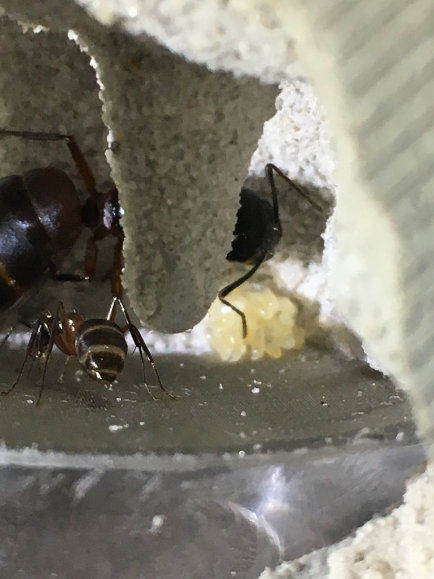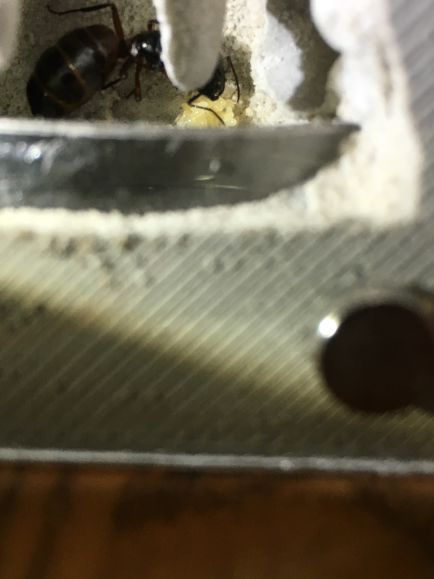- Formiculture.com
- Forums
- Gallery
- Members
- Member Map
- Chat

C. novaeboracensis vs C. chromaiodes
Started By
Nylanderiavividula
, Mar 10 2019 6:39 AM
4 replies to this topic
#1
 Offline
-
Posted March 10 2019 - 6:39 AM
Offline
-
Posted March 10 2019 - 6:39 AM
I have a small colony (q, two workers, varying brood stages) of SOMETHING that I thought were C. novaeboracensis but am now unsure about. I am starting to wonder if they are C. chromaiodes simply based on where I live (middle-east Georgia, US). Antmaps.org shows these two species being native to Georgia, but other sites indicate that novos are generally further north and chromas are predominately what you find in the southeast... Can anyone here point me in the direction of distinguishing characteristics of these two species?! I don’t HAVE to know, but it is kinda’ eating me up. I have tried the search function of this site with various keywords to find the answer to the question but when the find comes back the awesome doggone journals pop up and I gleefully “waste” an hour or two down that wonderful rabbit hole... (if you are reading this and haven’t looked at Rs’s Camponotus journals, I recommend doing so!). Thanks in advance for any responses!
- Rstheant likes this
Camponotus castaneus
Camponotus chromaiodes (Pretty sure...)
Brachymyrmex patagonicus
Aphaenogaster sp. (I’ll be working on this species ID, soon)
Pheidole crassicornis
Camponotus chromaiodes (Pretty sure...)
Brachymyrmex patagonicus
Aphaenogaster sp. (I’ll be working on this species ID, soon)
Pheidole crassicornis
#2
 Offline
-
Posted March 10 2019 - 6:53 AM
Offline
-
Posted March 10 2019 - 6:53 AM
Having owned both, I can tell you that C. novaeboracensis have a maroon red thorax, while chromaiodes have some light red on the worker's thorax, with the queens having red legs, so.e red on the gaster, and a faint tint o n the thorax.
Hope this helps!
Hope this helps!
- Nylanderiavividula likes this
My Main Journal | My Neivamyrmex Journal | My Ant Adoption | My YouTube
Join the TennesseeAnts Discord Server! https://discord.gg/JbKwPgs
#3
 Offline
-
Posted March 10 2019 - 10:00 AM
Offline
-
Posted March 10 2019 - 10:00 AM
C. novaeboracensis are like C. hyatti, as per their coloring. Hyatti can also be black too. Only difference is that mrymentoma Camponotus are smaller than your average large Camponotus.
http://www.formicult...notus-fragilis/
http://www.formicult...l-discontinued/
http://www.formicult...notus-fragilis/
http://www.formicult...l-discontinued/
Edited by Rstheant, March 10 2019 - 10:05 AM.
- YsTheAnt and TennesseeAnts like this
#4
 Offline
-
Posted March 11 2019 - 12:18 AM
Offline
-
Posted March 11 2019 - 12:18 AM
Easiest and surest way to tell apart the two species is that C. chromaiodes have noticably long and rather thick coat of golden hair on their gaster. Additional characteristics is the X shaped pattern on the back of C. novaeboracensis queens, both queens and workers normally have completely red thoraxes but the hue varies. C. chromaiodes queens tend to have black thoraxes with red highlights (like C. herculeanus), as well as the front portion of the gaster being red. Workers of C. chromaiodes also tend to have some black on their thorax. Size wise C. chromaiodes queens are typically larger, around 16mm vs 15mm.
Edited by LC3, March 11 2019 - 12:19 AM.
- TennesseeAnts and AntsBC like this
#5
 Offline
-
Posted March 15 2019 - 3:31 PM
Offline
-
Posted March 15 2019 - 3:31 PM
Here we go guys! Thanks for the feedback. I finally put my mind towards figuring out how to post pictures on here...so...what is this physogastric beauty? I suspect what I had been calling a nova is a chroma, but you tell me!


Look at that nice egg pile!!
Camponotus castaneus
Camponotus chromaiodes (Pretty sure...)
Brachymyrmex patagonicus
Aphaenogaster sp. (I’ll be working on this species ID, soon)
Pheidole crassicornis
Camponotus chromaiodes (Pretty sure...)
Brachymyrmex patagonicus
Aphaenogaster sp. (I’ll be working on this species ID, soon)
Pheidole crassicornis
1 user(s) are reading this topic
0 members, 1 guests, 0 anonymous users















